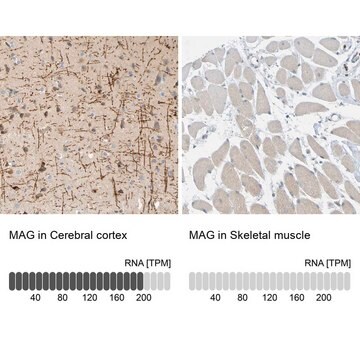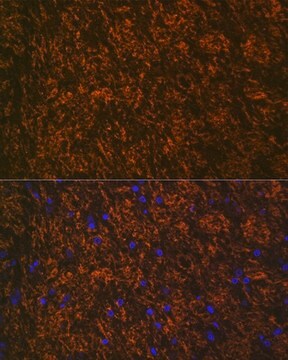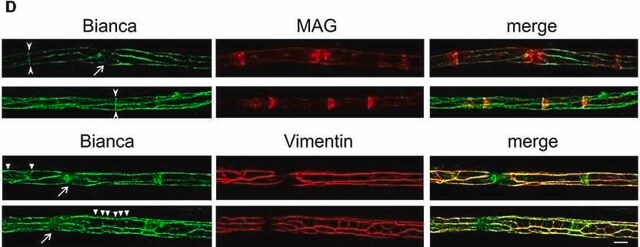SAB1401236
Anti-MAG antibody produced in mouse
purified immunoglobulin, buffered aqueous solution
Sign Into View Organizational & Contract Pricing
All Photos(1)
About This Item
Recommended Products
biological source
mouse
Quality Level
conjugate
unconjugated
antibody form
purified immunoglobulin
antibody product type
primary antibodies
clone
polyclonal
form
buffered aqueous solution
species reactivity
human
technique(s)
western blot: 1 μg/mL
NCBI accession no.
UniProt accession no.
shipped in
dry ice
storage temp.
−20°C
target post-translational modification
unmodified
Gene Information
human ... MAG(4099)
General description
The protein encoded by this gene is a type I membrane protein and member of the immunoglobulin superfamily. It is thought to be involved in the process of myelination. It is a lectin that binds to sialylated glycoconjugates and mediates certain myelin-neuron cell-cell interactions. Two alternatively spliced transcripts encoding different isoforms have been described for this gene. (provided by RefSeq)
Immunogen
MAG (NP_002352.1, 1 a.a. ~ 626 a.a) full-length human protein.
Sequence
MIFLTALPLFWIMISASRGGHWGAWMPSSISAFEGTCVSIPCRFDFPDELRPAVVHGVWYFNSPYPKNYPPVVFKSRTQVVHESFQGRSRLLGDLGLRNCTLLLSNVSPELGGKYYFRGDLGGYNQYTFSEHSVLDIVNTPNIVVPPEVVAGTEVEVSCMVPDNCPELRPELSWLGHEGLGEPAVLGRLREDEGTWVQVSLLHFVPTREANGHRLGCQASFPNTTLQFEGYASMDVKYPPVIVEMNSSVEAIEGSHVSLLCGADSNPPPLLTWMRDGTVLREAVAESLLLELEEVTPAEDGVYACLAENAYGQDNRTVGLSVMYAPWKPTVNGTMVAVEGETVSILCSTQSNPDPILTIFKEKQILSTVIYESELQLELPAVSPEDDGEYWCVAENQYGQRATAFNLSVEFAPVLLLESHCAAARDTVQCLCVVKSNPEPSVAFELPSRNVTVNESEREFVYSERSGLVLTSILTLRGQAQAPPRVICTARNLYGAKSLELPFQGAHRLMWAKIGPVGAVVAFAILIAIVCYITQTRRKKNVTESPSFSAGDNPPVLFSSDFRISGAPEKYESERRLGSERRLLGLRGEPPELDLSYSHSDLGKRPTKDSYTLTEELAEYAEIRVK
Sequence
MIFLTALPLFWIMISASRGGHWGAWMPSSISAFEGTCVSIPCRFDFPDELRPAVVHGVWYFNSPYPKNYPPVVFKSRTQVVHESFQGRSRLLGDLGLRNCTLLLSNVSPELGGKYYFRGDLGGYNQYTFSEHSVLDIVNTPNIVVPPEVVAGTEVEVSCMVPDNCPELRPELSWLGHEGLGEPAVLGRLREDEGTWVQVSLLHFVPTREANGHRLGCQASFPNTTLQFEGYASMDVKYPPVIVEMNSSVEAIEGSHVSLLCGADSNPPPLLTWMRDGTVLREAVAESLLLELEEVTPAEDGVYACLAENAYGQDNRTVGLSVMYAPWKPTVNGTMVAVEGETVSILCSTQSNPDPILTIFKEKQILSTVIYESELQLELPAVSPEDDGEYWCVAENQYGQRATAFNLSVEFAPVLLLESHCAAARDTVQCLCVVKSNPEPSVAFELPSRNVTVNESEREFVYSERSGLVLTSILTLRGQAQAPPRVICTARNLYGAKSLELPFQGAHRLMWAKIGPVGAVVAFAILIAIVCYITQTRRKKNVTESPSFSAGDNPPVLFSSDFRISGAPEKYESERRLGSERRLLGLRGEPPELDLSYSHSDLGKRPTKDSYTLTEELAEYAEIRVK
Biochem/physiol Actions
Myelin-associated glycoprotein (MAG) is a sialic binding protein and is comprised of five Ig-like domains. It is found in both CNS and PNS myelin, and is very essential for maintenance of both myelin and myelinated axons. It is potent inhibitor of axonal regeneration, and is primarily expressed at the axoglial junction in oligodendrocyte processes. Deletion of MAG region leads to Kearns-Sayre syndrome characterized by oligodendrocyte loss and nuclear translocation of apoptosis-inducing factor. MAG also has been reported as an important inhibitor of axonal regeneration.
Physical form
Solution in phosphate buffered saline, pH 7.4
Not finding the right product?
Try our Product Selector Tool.
recommended
Product No.
Description
Pricing
Storage Class
10 - Combustible liquids
flash_point_f
Not applicable
flash_point_c
Not applicable
Certificates of Analysis (COA)
Search for Certificates of Analysis (COA) by entering the products Lot/Batch Number. Lot and Batch Numbers can be found on a product’s label following the words ‘Lot’ or ‘Batch’.
Already Own This Product?
Find documentation for the products that you have recently purchased in the Document Library.
Zixuan Cao et al.
The Journal of neuroscience : the official journal of the Society for Neuroscience, 27(34), 9146-9154 (2007-08-24)
Myelin-associated glycoprotein (MAG) is a potent inhibitor of axonal regeneration. It contains five Ig-like domains and is a sialic binding protein. Previously, we showed that the sialic acid binding site on MAG maps to arginine 118 in Ig domain 1
Nichola Z Lax et al.
Archives of neurology, 69(4), 490-499 (2012-04-12)
To explore myelin components and mitochondrial changes within the central nervous system in patients with well-characterized mitochondrial disorders due to nuclear DNA or mitochondrial DNA (mtDNA) mutations. Immunohistochemical analysis, histochemical analysis, mtDNA sequencing, and real-time and long-range polymerase chain reaction
Our team of scientists has experience in all areas of research including Life Science, Material Science, Chemical Synthesis, Chromatography, Analytical and many others.
Contact Technical Service








